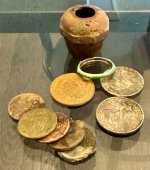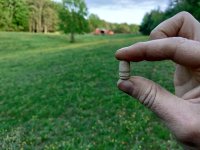Rocsteddie
Full Member
- Jun 17, 2014
- 184
- 182
- Primary Interest:
- Other
Found this stone in Northern Mn. just laying on top of the ground.
Near old mine dumps .
It is magnetic mostly with a few small areas that are not.
I have no idea how or why these white rectangular objects ended up attached to this stone.
Scrub stone with soap and water really hard with no change.
Thanks for interest and any info View attachment 1247783 View attachment 1247784 View attachment 1247785 View attachment 1247786
Near old mine dumps .
It is magnetic mostly with a few small areas that are not.
I have no idea how or why these white rectangular objects ended up attached to this stone.
Scrub stone with soap and water really hard with no change.
Thanks for interest and any info View attachment 1247783 View attachment 1247784 View attachment 1247785 View attachment 1247786



![00240 IMG_5767 diabase[1].jpg 00240 IMG_5767 diabase[1].jpg](https://www.treasurenet.com/data/attachments/1142/1142337-50cb279ee61f6cb42c46eeb910963c15.jpg)



